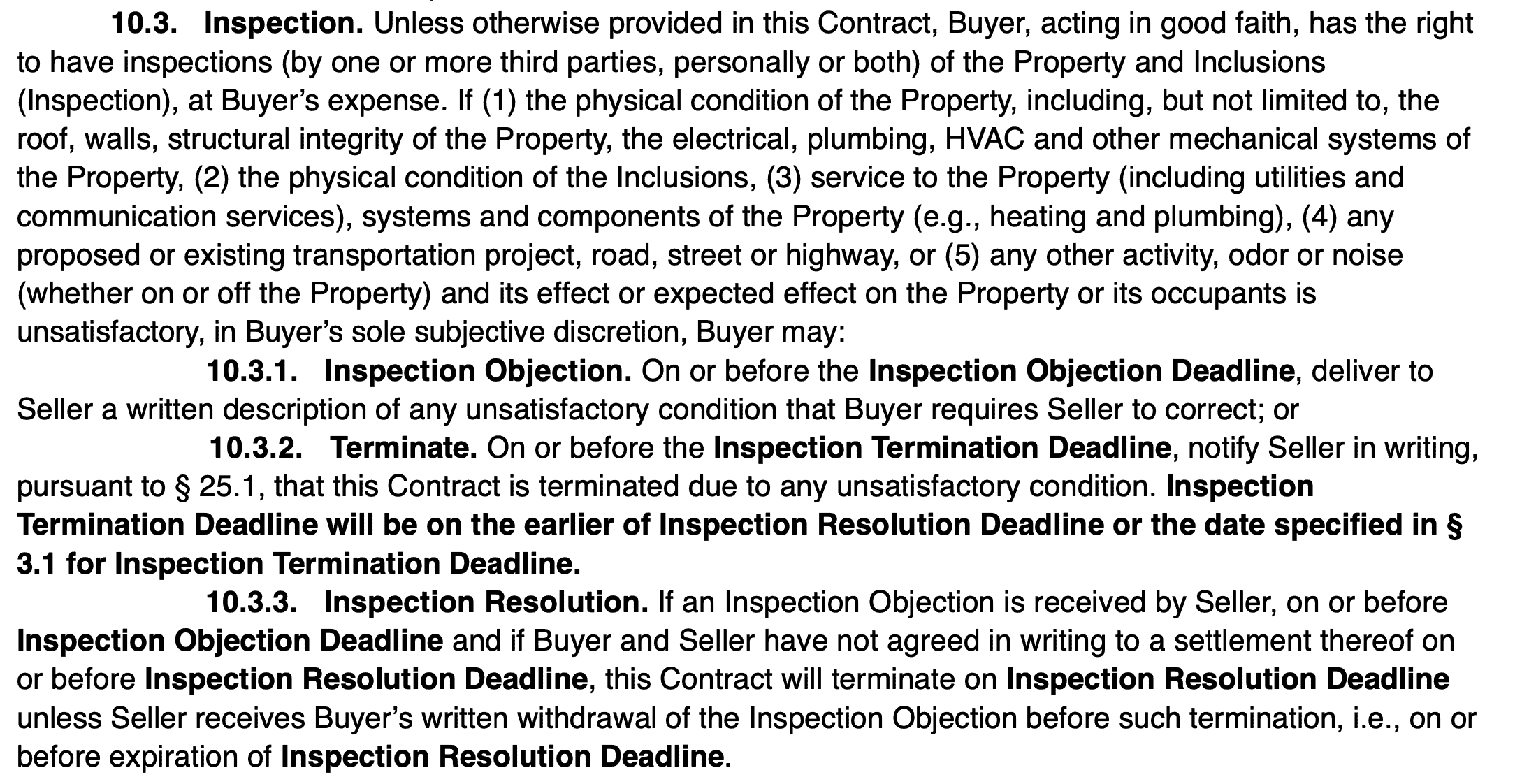For most people, buying a home is a purchase that involves both emotion and intuition. Once the decision to purchase a particular home is made, the conscious mind searches for rational evidence to justify that purchase.
This is OK, as long as there are no real problems with the property. The Home Inspection is a great opportunity to let the rational mind catch up to our more emotional side.
Disclosure
The first step in the home inspection process is to review any disclosure information available from the home seller. Homebuyers often assume the sellers are hiding the true condition of their home. Sometimes they are, but most of the time they’re not. The Colorado real estate contract specifically states:
“Sellers shall disclose to the buyer, in writing, any latent defects actually known by the seller.” This disclosure is usually made in the form of a document known as the Sellers Property Disclosure or SPD.
This is the seller’s opportunity to disclose any known issues with the property. The form is set up in sections that guide the seller through each major aspect of the property. The SPD simply presents the seller with questions about the property. The seller answers these questions with a simple yes if there has been a problem. If there are any problems, there is an opportunity for the seller to explain the condition and talk about any repairs in the comments section.
Here is an example of the roofing section of the disclosure.

Although disclosure certainly helps, it’s by no means a guarantee and still doesn’t help us with what the owner doesn’t know. This is where the actual Home Inspection comes in.
General Home Inspection
Most real estate contracts have an Inspection Contingency built-in. This means the buyer has the right to do inspections and terminate the contract based on the results of those inspections. Even in an as-is sale, the buyer usually has the right to perform inspections.

The most important decision you can make at this point is who is going to do the actual inspection. Your REALTOR® can give you a list of good inspectors. Additionally, friends that have recently bought homes are more than happy to share their inspector’s name, especially if it went well.
You can also search the review websites like Angie’s list. If you take one thing away from this article, choose a professional, not a friend who has experience in the trades or building homes. It’s fine to ask your friend about a specific item that might fall into their field of expertise after the inspection but please don’t bring them to the inspection.
At this point in the process, all you should be trying to do is get an overall idea of the property condition. If during the inspection, red flags show up, we would defer to a specialist (Plumber, Electrician, Roofer, etc…). You should think of the inspection like your annual physical, You go to a general practitioner for your physical, you wouldn’t go to a specialist until you know you needed one.
Look For a Certified Inspector
Certification is the starting point in a search for your inspector. Home inspectors are not licensed, they are certified. The two primary certifying organization for home inspectors are ASHI or the American Society of Home Inspectors and the International Association of certified or InterNACHI.
Home inspectors with certifications follow a strict set of guidelines or standards of practice when it comes time to do the actual inspection. It’s a good idea to look over those guidelines prior to the actual inspection. You can download a copy of these guidelines from the ASHI website or just click here and download them right here: ASHI Standards and InterNACHI
If you have an area of concern and don’t see it mentioned in the guidelines, ask your inspector to take a look at it. They are generally happy to oblige unless inspecting the item puts them in danger of bodily harm or potentially causes damage to the home. Unlike the inspectors on television home shows, real-life, “certified” inspectors won’t damage property during the inspection.
The Actual Inspection
Depending on the size of the house, a general home inspection can cost $250 to $600 and takes between 2 to 6 hours. If you have additional buildings, structures, etc those will all add expense.
At the inspection, the best thing a buyer can do is to follow the inspector, closely! The inspector will usually get to the house a little early so they can walk the exterior and get the roof inspection done before the buyer gets there. This helps expedite the entire inspection process and since they aren’t going to let the buyer get on the roof with them (liability insurance rules) it helps avoid having to say no if the buyer asks.
A good inspector will explain what they are seeing, especially when there is a problem. They should also explain the not-so-obvious elements of the home, things like aluminum wiring, or an existing firewall. If you don’t understand what’s going on, it’s imperative that you ask questions and seek clarification. This will pay off, especially when it comes time to put together the Inspection Objection.
At the conclusion of the inspection, the inspector will summarize their findings. Some inspectors will actually produce and print a report on site. If they don’t have this capability, they should mail or e-mail you a thorough report with enough time to put together your inspection objection.
Inspection Add-Ons
There are a number of additional issues not included in a general home inspection that a home buyer should think about when it comes to the Home Inspection phase of the sale. Some of these items are regional, specific to the state, climate, etc. Your real estate professional can advise, and your home inspector will also make suggestions on what additional inspections to request.
Radon – Radon gas is a prevalent issue in the state of Colorado and the region. It is a gas emitted from the break down of rock/granite in the soil. It’s all over our area, but it happens to be heavier than the oxygen we breathe, so it’s tested at the lowest level of the home. Different companies administer the test in various ways, but usually, a minimum 48-hour test is best to collect data. Radon can be mitigated from $900-1500. Get more important information about Radon.
Mold – Most home inspectors will not claim to inspect for mold, but will check for visual areas that appear to have excessive moisture or discoloration consistent with mold. They will then recommend an environmental specialist to take surface and air samples to be sent to a lab.
Termites – Termites are extremely uncommon here because of the cold winters, arid climate (and maybe altitude). I will not say they don’t exist, but in 14 years (hundreds of sales) I’ve had termites spotted by an inspector in 1 home. Sometimes foreclosures with out of state banks will require termite inspection because it is common in other places. Sometimes that requirement can be waived. Again, good inspectors know the “flags” that might indicate an issue and will alert you to consult a pest control specialist.
Meth – Colorado is one of the most lenient states on multiple offenders, so meth use and cooking are fairly common. The sad part is the residue remains in everything… fabrics, drywall, etc. Meth tests can be done by environmental specialists as well, for $500-2000 depending on the number of areas tested. Mitigation requires going all the way to studs to completely remediate the space, to the tune of thousands! People often think it’s just an issue in poorer neighborhoods or downtown areas, but the sad fact is meth has been found all over the city all the way up into the million-dollar price range.
Well – For about $300 you can have a well company inspect all the equipment and perform a 2-hour pressure test. While this might seem like a lot, it can help find a hidden issue on a system seemingly working “just fine”… like the recent well pressure tank that needed replacement. Thankfully it was discovered before closing, giving my clients the opportunity to request a replacement by the sellers!
Water Quality – El Paso County will do water bacteriological testing. It’s not expensive ($40 I think), but the collection container and process are very specific and the county requires submission in a short amount of time after collection. In most cases, the lender REQUIRES this test if the property has a well.
Septic Inspection – It used to be up to the buyer to inspect or request that seller have the septic inspected. Effective January 2015, the seller now carries the obligation and title will not transfer nor loan funds until a septic inspection is complete. This regulation is new to El Paso County, however other counties have been requiring this for a while. Each county or region has a list of approved inspectors on their website. Some are easier than others to bring into compliance.
Sewer Line Scope – The purpose of a sewer line inspection is to see if sewer lines are obstructed, cracked, or outdated. You will want to make sure the line is working properly as the cost to repair and tap into the city’s mainline can be very expensive. This test usually runs about $150 and most plumbers will provide a digital recording as your proof that it is working properly.
Lead-Based Paint Assessment – A Lead-Based Paint test is a good idea for homes built prior to 1978 due to the fact that paint manufactured during that time contained lead. Lead poisoning could be potentially fatal to young children if swallowed. A test usually runs $300.
The Inspection Objection
The inspection objection is a document itemizing what the buyer deems to be unsatisfactory physical conditions they want to be corrected on the property prior to closing. Generally, we see three potential approaches when putting together this document, here they are:
- The first is written without much thought and simply asks for everything and anything the inspector found. This type of request is generally met with anger and resistance by the home seller and is more likely to produce a complete rejection of everything the buyer asks for then it is at producing any kind of constructive resolution. This is why we suggest buyers actually follow the inspector, this way they get a sense of what is really a big deal, what’s not, and what’s just normal maintenance. Inspection objections are the fastest way to kill a real estate transaction. And asking for everything is the best way to get nothing while losing the deal and the money you paid for the inspection.
- The second type of inspection objection is the one where the buyer asks for nothing. This is fine if the buyer has participated in the inspection and legitimately believes there is nothing that needs to be done. The other reason to use this tactic is when the buyer really wants the house or feels like they are getting such a great deal they don’t want to jeopardize the transaction. So, they are essentially waving the inspection contingency. If this is the route you choose to go we think it’s important to note that it’s still a good idea to do an inspection in order to get a good sense of the overall property condition.
- The third type of inspection objection is the one where the buyer participates in the inspection, thoughtfully considers everything the inspector found, seeks advice from their REALTOR®, and any appropriate contractors in order to get a sense of how much repairs might cost. Once they’ve done this, they put together a realistic list of repairs they would like the seller to take care of prior to the closing. Having done their homework, this buyer knows how much things cost so if the seller comes back with a monetary alternative resolution, the buyer knows where they stand, what’s fair, and what’s not. This type of negotiation tends to net a better result at the end of the day.
Negotiating After the Inspection
After the inspection, the buyer has the right to object to any unsatisfactory conditions that are brought to their attention.
The buyer may either ask the seller to fix the problems in the form of repair requests or simply terminate the contract. It is important that all of this be done using the correct form of notice as well as in the time frame outlined in the contract. Here are the important terms related to the inspection objection and resolution phase of your transaction:
- Inspection objection– This is the written notice to the seller from the buyer describing what they deem as unsatisfactory physical conditions they want the seller to correct.
- Inspection objection deadline– This is the date by which the buyer needs to give the seller the written inspection objection.
- Notice to terminate– This is written notification from the buyer to the seller that the buyer is terminating the contract. This notice can begin at any point prior to the inspection objection date.
- Inspection resolution– The seller has a couple of options at this point. They can agree to fix everything on the list, thereby staying under contract. They can also propose addressing only certain items. For example, they could offer to fix only some of the things on the list or offer monetary compensation for the items. If the seller proposes this kind of alternative, the buyer must accept this in order to stay under contract.
When you look at the language about deadlines contained in this clause, it should become apparent just how important it is to perform within these time frames. Failure to do so could result in loss of earnest money or worse, loss of the opportunity to purchase the property. For sellers, failure to meet these deadlines could result in losing a potential sale.
Negotiating after the home inspection can be difficult but with the right preparation and a little knowledge, the inspection phase of the transaction can produce a win/win for both buyers and sellers.
Home Inspection Takeaways
The inspection might be the most important aspect of a real estate transaction. As we mentioned at the beginning of this article, it’s your rational sides opportunity to reason with your emotional sides impulse to buy a home that might become a problem later on. Remember, once you close on the property you own the problems useless you want to undergo costly litigation.
Make sure to perform all of your inspection due diligence in a timely manner, your emotional side will thank you.

